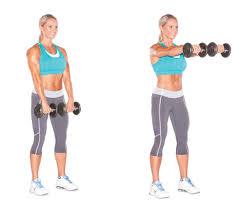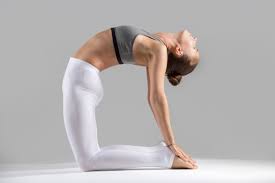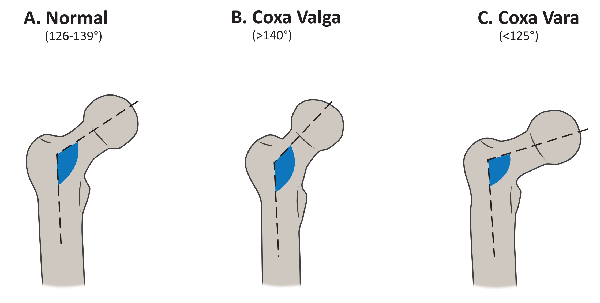Front Raise Exercise: Muscle worked, Health Benefits, How to do?, Variations
What is the front raise exercise?
The front raise is a weight training exercise. this is an isolation exercise that isolates the movement of the shoulder joint by doing shoulder flexion only. It primarily targets your anterior deltoid, with assistance from the serratus anterior, biceps brachii, and clavicular portions of the pectoralis major.
This exercise mainly targets the front of the shoulders. This muscle is used in shoulder flexion.
The front raise is also called the dumbbell front raise. Do front raises in standing and using an overhand grip to raise a pair of dumbbells from the front of your thighs to shoulder level in front of your body, With perfect form, front raises are an effective shoulder workout with more benefits.
It can be performed very easily at your home if you have dumbbells with you. Having a dumbbell with adjustable weights will allow you to increase the load. when your strength increases.

Which muscles are used for front raise exercise?
Primarily target the front of the shoulder muscle called the anterior deltoid.
Front dumbbell raises also use the lateral deltoid and the serratus anterior, along with the upper and lower trapezius, clavicular part of the pectoralis major, and biceps.
Benefits of Doing Front Raises front raise exercise
Consider the benefits of regularly performing front raises.
- This exercise tones your shoulder muscles.
- The front raise is an isolation exercise that activates the muscle groups in your shoulders—specifically, The anterior deltoid muscles also called the front deltoids. By contracting your anterior deltoids, this exercise enhances the size and tone of your shoulders.
- This exercise helps to improve shoulder flexion range.
- This exercise requires your shoulder joint to go through a full range of motion, increasing mobility. Additionally, front raises contract your shoulder flexor muscles, including the anterior deltoid and pectoralis major clavicular part.
- This exercise uses multiple muscle groups in your upper body.
- Helps to maintain upper limb strength.
- Helps to maintain mobility and stability of shoulder joint.
- Helping for overhead movements.
How to Do Front Raises With Perfect Form?

For the front raise, you have to start with completing 3–4 sets of 10–12 repetitions. Choose your sets and repetitions based on your capacity to maintain perfect form, focusing on a form before moving up to larger weights.
- Hold a pair of dumbbells, and get in the initial position. stand with your feet shoulder-width apart and slightly flex your knees.
- Your posture should be tall with your trunk straight and your shoulders over your hip joint. you have to Maintain your head and neck in a neutral position.
- Your chin should be tucked throughout the motion as if you were holding an egg under your chin.
- Evenly distribute weight along each entire foot, and grip the ground with your feet to maintain balance. grab the dumbbells in front of your body with your palms facing your legs. Your arms should belong with a slight bend in your elbows. Pr-tension your shoulders and hips while contracting your core.
- Every repetition should start from this position. smoothly raise your arms away from your body. raise your arms until your elbows are in line with your shoulder joint or just below your shoulder joint. Allow the shoulder blades to go naturally with the shoulder joints.
- Your palms should be facing the ground at the top of the movement.
- Hold for a couple of seconds before you take dumbbells down.
- Slowly lower your arms to return the dumbbells to the initial position.
There have different Front Raise Variations, which are explained below
Once you have practiced the basic front raise exercise, then move to the front raise variation in your routine by trying one of these variations of front raise.
Seated dumbbell front raise:
How to do it?
- For this variation, you have to sit on a flat bench with your feet shoulder-width apart, grab a dumbbell in both hands with an overhead grip at your sides.
- Slowly raise your both arms towards the ceiling, hold for a couple of seconds then slowly lower your arms down, and return to the initial position.
Wall Supported Dumbbell Front Raise
When you will do a regular front raise exercise, then there is a tendency to use more body momentum. This activates other muscles like the trapezius and back to swing upward. To prevent this, we can perform front raises with the back supported on the wall to prevent swinging on the back.
How to do it?
- You have to stand closer to the wall with your back fully supported on the wall while holding dumbbells in both. your hands should be straight on the side. stand with your feet shoulder-width apart and slightly flex your knees.
- Your posture should be tall with your trunk straight and your shoulders over your hip joint.
- You have to Maintain your head and neck in a neutral position. Your chin should be tucked throughout the motion as if you were holding an egg under your chin. Evenly distribute weight along each entire foot, and grip the ground with your feet to maintain balance.
- Grab the dumbbells in front of your body with your palms facing your legs. Your arms should belong with a slight bend in your elbows. Pr-tension your shoulders and hips while contracting your core. every repetition should start from this position.
- Smoothly raise your arms away from your body towards the ceiling. raise your arms until your elbows are in line with your shoulder joint or just below your shoulder joint. Allow the shoulder blades to go naturally with the shoulder joints.
- Your palms should be facing the ground at the top of the movement.
- Hold for a couple of seconds before you take dumbbells down.
- Slowly lower your arms to return the dumbbells to the initial position.
Barbell front raise
In this variation you have to use a barbell instead of a pair of dumbbells, this variation evenly distributes the weight and involves a shorter range of motion than the dumbbell exercise
How to do it?

- Grab a barbell and get in the initial position, stand with your feet shoulder-width apart, and slightly flex your knees. Your posture should be tall with your trunk straight and your shoulders over your hip joint.
- You have to Maintain your head and neck in a neutral position. Your chin should be tucked throughout the motion as if you were holding an egg under your chin. Evenly distribute weight along each entire foot, and grip the ground with your feet to maintain balance.
- Grab the barbell in front of your body with your palms facing your legs. Your arms should be straight with a slight bend in your elbows. Pr-tension your shoulders and hips while contracting your core. every repetition should start from this position.
- Smoothly raise your arms away from your body towards the ceiling. raise your arms until your elbows are in line with your shoulder joint or just below your shoulder joint. Allow the shoulder blades to go naturally with the shoulder joints. Your palms should be facing the ground at the top of the movement.
- Hold for a couple of seconds before you take the barbell down.
- Slowly lower your arms to return the barbell to the initial position.
Incline Barbell Front Raises (Back On The Bench)
This is another way to do front raises. Here, your back will be supported on the bench and you will be in a half-seated position. This is an excellent functional exercise that will involve your core muscles in the movement, which makes it more athletic.
How to do it?
- Hold a barbell in your hands. Your chin should be tucked throughout the motion as if you were holding an egg under your chin. Evenly distribute weight along each entire foot, and grip the ground with your feet to maintain balance.
- Grab the barbell in front of your body with your palms facing your legs. Your arms should belong with a slight bend in your elbows. Pr-tension your shoulders and hips while contracting your core. every repetition should start from this position.
- Smoothly raise your arms away from your body towards the ceiling. raise your arms until your elbows are in line with your shoulder joint or just below your shoulder joint.
- Allow the shoulder blades to go naturally with the shoulder joints. Your palms should be facing the ground at the top of the movement.
- Hold for a couple of seconds before you take a barbell down.
- Slowly lower your arms to return to the initial position.
Front incline dumbbell raise
This variation allows you for a greater range of motion than the basic front raise.
How to do it?
- For this exercise, you have to sit on an incline bench at a 45 to 50-degree angle and raise pair of dumbbells from your sides. Your chin should be tucked throughout the motion as if you were holding an egg under your chin.
- Evenly distribute weight along each entire foot, and grip the ground with your feet to maintain balance.
- Grab the dumbbells in front of your body with your palms facing your legs. Your arms should belong with a slight bend in your elbows-Pr tension your shoulders and hips while contracting your core. every repetition should start from this position.
- Smoothly raise your arms away from your body towards the ceiling. raise your arms until your elbows are in line with your shoulder joint or just below your shoulder joint. Allow the shoulder blades to go naturally with the shoulder joints. Your palms should be facing the ground at the top of the movement.
- Hold for a couple of seconds before you take a dumbbell down.
- Slowly lower your arms to return to the initial position.
Alternating dumbbell front raise
This variation involves unilateral arm movement.
How to do it?
- Hold one dumbbell in your right hand, and get in the initial position. stand with your feet shoulder-width apart and slightly flexed knees.
- Your posture should be tall with your trunk straight and your shoulders over your hip joint. you have to Maintain your head and neck in a neutral position.
- Your chin should be tucked throughout the motion as if you were holding an egg under your chin. Evenly distribute weight along each entire foot, and grip the ground with your feet to maintain balance.
- grab the dumbbell in front of your body with your palms facing your legs. Your arm should be straight with a slight bend in your elbows. Pr-tension your shoulders and hips while contracting your core.
- Every repetition should start from this position.
- Smoothly raise your arm away from your body towards the ceiling. raise your arm until your elbow is in line with your shoulder joint or just below your shoulder joint. Allow the shoulder blades to go naturally with the shoulder joints.
- Your palm should be facing the ground at the top of the movement.
- Hold for a couple of seconds before you take the dumbbell down.
- Slowly lower your arms to return the dumbbells to the initial position. then go for the left side with the same movement.
Weight plate front raise:
How to do it?
- Hold a weight plate on either side with your thumbs pointing upward. you have to Stand tall and allow your arms to hang fully straight in front of your body.
- Maintaining a slight flexion in your elbows, lift the plate until your arms are parallel with the floor.
- Hold for a couple of seconds, and then slowly lower the weight plate back to the starting position.
Kettle bell front raise
How to do it?
- Grab a kettle bell in both hands, and get in the initial position. stand with your feet shoulder-width apart and slightly flexed knees. Your posture should be tall with your trunk straight and your shoulders over your hip joint.
- You have to Maintain your head and neck in a neutral position. Your chin should be tucked throughout the motion as if you were holding an egg under your chin. Evenly distribute weight along each entire foot, and grip the ground with your feet to maintain balance.
- Grab the Kettle bell in front of your body with your palms facing your legs. Your arms should be straight with a slight bend in your elbows. Pr-tension your shoulders and hips while contracting your core. every repetition should start from this position.
- Smoothly raise your arms away from your body towards the ceiling. raise your arms until your elbows are in line with your shoulder joint or just below your shoulder joint. Allow the shoulder blades to go naturally with the shoulder joints. Your palms should be facing the ground at the top of the movement.
- Hold for a couple of seconds before you take Kettle bell down.
- Slowly lower your arms to return the Kettle bell to the initial position.
Cable Front Raises
How to do it?
For this variation, you need a rope and pulley. Hook the pulley at a lower part of a cable machine and attach a straight bar to it.
- You have to stand with a shoulder-width stance with your back to the cable machine.
- Then, hold each end of the cable and stand straight with your hands extended down at the front.
- Raise your arms towards the ceiling hold at shoulder height. then return to the initial position by lowering the arm return to the starting position and repeat the movement.
Incline Cable Front Raises
How to do it?
- For this exercise, you have to Attach both the handles at the lower end of a cable machine and place an incline bench in between.
- Fix the bench at about a ninety-degree angle.
- hold both the handles from both hands and lie down onto the bench. not bend Your neck and lower back too much.
- Slowly raise your arms forward and hold at shoulder height. you will feel the tension in your front deltoids.
- Slowly bring your arms downward and stretch your shoulder at the bottom.
Lying Cable Front Raise
Here is another different variation of front raise for you where your body is resting on the ground and you can only use your front deltoid muscles to move the cables. You can also combine this exercise with another cable exercise to make it a superset and do that at the end of the workout.
How to do it?
- Lie down on the yoga mat withholding both ends of the cable. put your hands on the thigh and this will be your initial position.
- Start the exercise by moving your arms up towards the ceiling with slight flexion in the elbow. contract your front deltoids as you raise your arm.
- Hold for a second at the top movement and then slowly return to the initial position.
Note : You may be thinking that all these variations are similar to each other. But all these variations of this exercise utilize your front deltoids at a different angle which makes it different. So in each of these exercise variations, your deltoid muscles will undergo different stress to build more strength.
How to Work out Safely and Avoid Injury?
- If you have a past or per-existing health condition that is not good, then consult your physician before starting this exercise. Proper exercise technique is needed to ensure the effectiveness and safety of an exercise program, but you may need to modify every exercise to attain maximal results based on your needs.
- Always select a weight that allows you to have full control of your body throughout the exercise.
- When doing any exercise, pay close attention to your body, and stop immediately if you feel any pain or discomfort.
- If you continuously progress and build body strength, then perform proper warm-ups, rest, and add some nutrition into your exercise program.
- Your exercise effects will ultimately be based on your ability to adequately recover muscles from your workouts.
- You have to take proper Rest for 24 to 48 hours before doing the same muscle groups exercise. Rest allow sufficient recovery to your muscle.
- If you have a past or current shoulder injury, consult with your doctor or physiotherapist about whether you should do this exercise or not.
- The rotation in this exercise can cause shoulder impingement and you may feel pain if you have a tendency toward tendinitis or bursitis in this joint.
- Don’t continue to do this exercise if you feel any pain.
- In a starting phase choose lightweight and aim to do 12 to 15 repetitions for two to three sets, or repeat this exercise for the number of sets and repetitions in your daily workout routine.
Common Mistakes
Avoid these mistakes to keep this exercise effective and safe.
Rocking
When performing this front raise, don’t rock or sway—always keep a strong and stationary trunk. If you sway or find that you are rocking back on your heels to complete the raise the weight, then use a lighter weight to perform this exercise.
Using Momentum
Do not use momentum to raise the dumbbell or kettle-bells, as this decreases the effectiveness of this exercise. lifting the weights too quickly allows momentum to decrease the tension within the muscles, especially at the top of the lift.
Excessive Weight
This is an exercise where you should not use heavy weights to lift it may cause you to fail at the end of an exercise. Putting more Load on the shoulder can stress this joint and happen injury.






